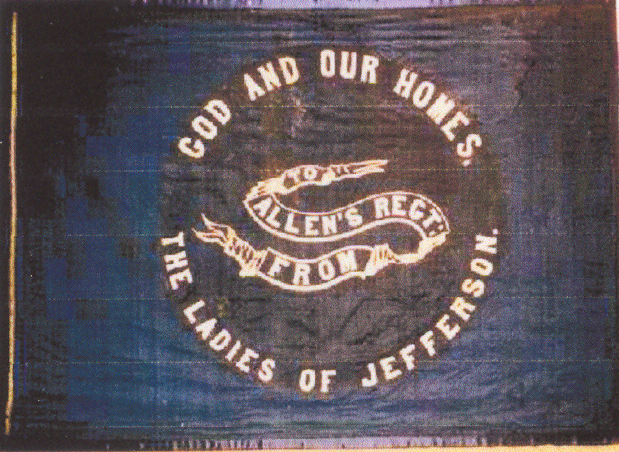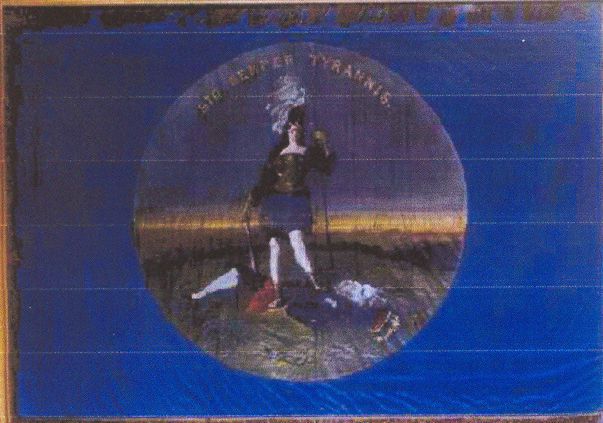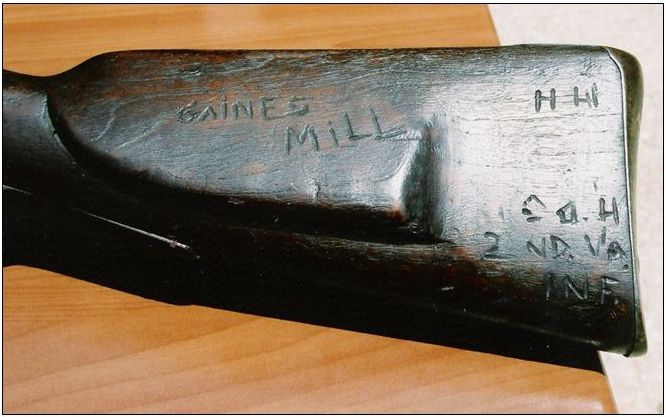|
This flag was made in Richmond, Virginia by George Ruskeil Manufacturers for the 2nd Virginia Regiment in the Spring of 1861
under the direction of Daniel B. Lucas of Charles Town. The companies composing the Second Regiment mostly belonged to Jefferson
and Clark Counties. The flag arrived in Winchester, Va. on the 17th July, just as the Brigade was about to leave for Manassas
Junction on 18th of July. The 1st Brigade marched out of Winchester with the flag flying at the head of the Second Virginia
Regiment. The purchase money was given me by Thomas Rutherford of Charles Town and several of his friends as a gift to the
Regiment. Thomas Rutherford did not desire to appear so prominent in the matter, so it was allowed to go as from the Ladies
of Jefferson County.
On the 21st of July, date of 1st Manassas, this was the only flag carried into the battle by the First Brigade and the
only Virginia flag in Jackson's command, other troops being put under his command after he arrived on the field. Soon after
1st Manassas Thomas J. Jackson was appointed Major General and took command of the First Division of the Army of Northern
Virginia; the Stonewall Brigade still holding its own, as the First Brigade of the Division. Colonel James Walkinson Allen
succeeded Jackson as its commander and not long afterward was killed at Gaines Mill on the 27th June 1862.
Due to confusion created by units carrying different flags after 1st Manassas the 30th October 1861 saw Governor Letcher
present every Virginia regiment with a bunting flag. Colonel Allen returned the 2nd Virginia's Flag to Charles Town for safe
keeping. Latter one afternoon in late 1861, Brigadier General Torbett of the U.S.Army was encamped around Charles Town with
his Cavalry command. His Staff officers had pitched their tents in the beautiful grounds surrounding the Rutherford home and
were lying all about on the grass. A little bare footed colored girl came into the yard and wound her way among them, carrying
a small package wrapped in a newspaper. Coming to a side door she handed the package to a member of the family saying, "Give
this to Miss Ginny Rutherford", and darted away. The Family never learned who the child was. Thomas Rutherford wrapped
the flag carefully and put it under an iron hearth in the bed-room where it remained until after the close of the war. There
were other treasures there also, which if they had been found by U.S.Soldiers, would have been to them ample reason for reducing
the home to ashes.
In 1920 Mrs. Virginia Rutherford McMechen wrote down the colourful history of the banner. Subsequently the flag came into
possession of her niece, Miss Emily T. Rutherford of Baltimore, Md, who presented it to the Virginia Military Institute in
January 1959. In 1976 this historic flag came into the care of Mrs. June Cunningham, VMI Museum Director. The museum has provided
it with a climate-controlled atmosphere while awaiting funds for professional restoration. In 1985 Mrs. Lise Putnam Liddell
of Houston, Texas generously provided the funds for restoration. It was restored by Ms. Becky Sudsbury of the Museum of Early
Southern Decorative Arts in Winston Salem, North Carolina. A proper case has been constructed for the flag and it is held
proudly at the VMI Museum.


Governor of Virginia John Letcher

Here is a .70 Cal. Bavarian M1842 "C.S., 1862" musket with a carved stock marked "H.H., 2ND VA INF, GAINES
MiLL". and 'CS' and '1862' on the lockplate".
The musket is believed to belong to William H. H. Crim who was A.W.O.L. on 22/9/1862 and returned 28/1/1863 and fined
one months pay. Due to diarrhea he was sent to Chimborazo Hospital in Richmond and returned 18/6/1863. He was again A.W.O.L.
on 1/7/1863 with no further record. He also had service in the 18th Virginia Cavalry, Company F. Possibly he was known as
"H.H." since maybe his Father John Crim (Co. D, who enlisted on 12/4/1862 at Guinea's Station, VA as a Private,
deserted on 12/7/62). His brothers or cousins: John Peter Crim (enlisted on 29/10/62 in Co. F as a Sergeant and wounded 11/63,
POW (Rebel deserter 23/11/64) and William Benjamin Crim a resident of Clarke Co and was wounded 11/64 and 25/3/65 had stayed
faithful to the Colors. George Crim enlisted19/4/61 at Darkesville, VA as a Corporal who was mustered into "H" Co.
VA 27th Infantry deserted on 14/5/61 at Harper's Ferry, WV.
The time-frame for "H.H.'s" service coincides with what is suspected to be an issue of the M1842 Bavarian "C.S.,
1862" to him and his participation at "GAINES MILL." His going AWOL on 22/9/1862 may indicate he took his Bavarian
musket home. When he returned, he may have claimed he "lost" his old musket, and was issued an Enfield or?
It was likely placed there by The Confederate Ordnance Deptartment., probably after it cleaned and inspected the musket,
before issuing the musket to an Army element in the field. Confederate Rifles & Muskets.A Pictorial Study by Dr. John
M. Murphy's, p 108: states "While sitting by a campfire, Confederate soldiers would carve their names [or initials] into
the stocks of their rifles (muskets) to show ownership. Many Confederate rifles (muskets) have been observed with carved initials,
names, artwork, and the name of battles including dates."
In 1860 Virginia had about 53,000 flintlock muskets and rifles and 1,600 percussion rifles, some 6,000 in the hands of
Militia but the great majority in Arsenals such as the State Armory in Richmond, the old "Virginia Manufactory of Arms"
which produced arms during 1802-1821. In April 1861, Virginia Militia captured the Federal weapons factory at Harper's Ferry
along with 4-5,000 serviceable M1855 .58 cal. rifles and muskets. The excellent arms production machinery from Harpers Ferry
went to Richmond which produced several hundred M1855-type muskets and rifles until August '61 when the "C.S. Ordnance
Department" was established in the old State Armory building, "which was rechristened the C.S. Armory." (Todd:
Armerican Military Equipage, 1851-1872)
"Most of the Virginia State Lines troops were issued Va. Manufactured flintlocks altered to percussion by the VA
Ordnance Dept. which moved to Lynchburg in the Shenandoah Valley. The Arms situation for all (Virginia) branches (infantry
and cavalry, etc.) gradually improved after Virginia troops were transferred to Confederate Service, and their armament became
the responsibility of the 'C.S. Ordnance Department.' Todd, p 1271. Confederate Agents Caleb Huse and Bulloch imported hundreds
of thousands of foreign arms" during 1861 and following years.
This Musket may have got into the hands of the 2nd Va. in time for the Battle at Gaines Mill on 27/6/62, from Bavaria/Germany
to the CSA in less than 6 months by Rail and Wagon. But it is more likely it was purchased earlier when it issued to the 2nd
Va. when they had Enfields .The Bavarian muskets and other European muskets were hurriedly purchased by both North and South
during mid-1861 if not earlier to meet desperate needs for arms. This particular Bavarian musket could have been imported
by either side, or possibly captured from the North and turned in to the CS Armory for inspection, stamped there, and issued
to the Valley Army, then the Stonewall Brigade, then the 2nd VA Infantry, especially to arm new recruits, or to replace battle
or other losses, or replace older, less reliable flintlock or converted muskets.
Researched by Musket owner Ed Besch, Mobile, Alabama - Member of the Company of Military Historians.
|

